Own your market this season with strategies by a pest control SEO experts: targeted keywords, clean site architecture, and technical SEO that keeps you ahead.
5.0

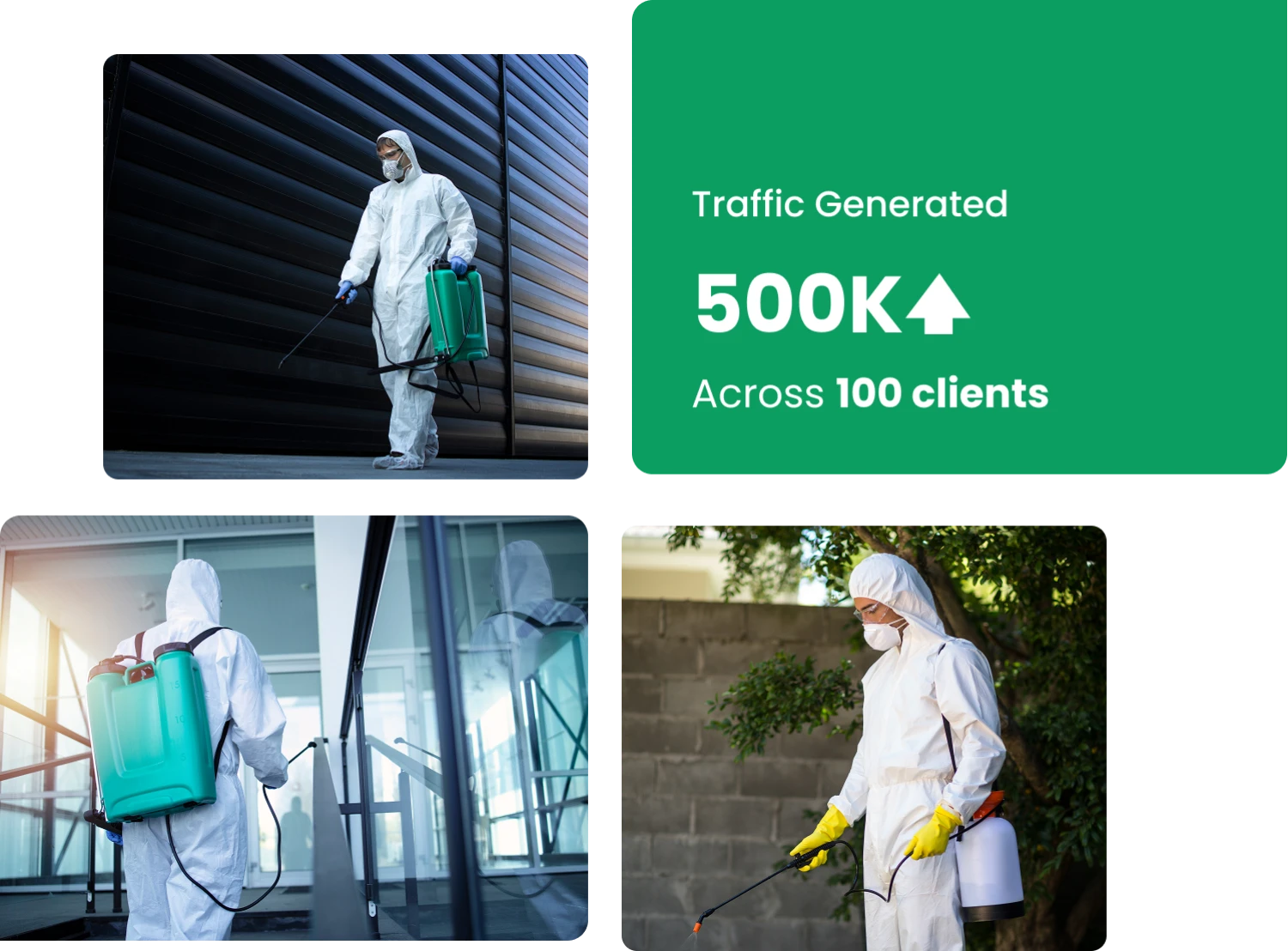

Ants in spring, wasps in summer, rodents in fall: pest control demand never hits evenly. One month, your schedule is light, the next it’s overflowing with calls. Between routing techs, crews, and compliance, marketing often gets pushed aside.
When those spikes hit, you need to be the company homeowners find first. Loyalty is low, so you’re constantly bringing in new customers. Paid ads cost $40–$45 per lead and stop when you stop paying.
That’s why SEO matters. In this pest control SEO guide, we’ll show exactly how to win those high-intent searches—“exterminator near me,” “pest control in [city],” and more—with step-by-step tactics across local pages, Google Business Profile, and top directories. Every recommendation is backed by our experience working with 75+ pest control companies.
Keyword research is the backbone of pest control SEO. So, let’s start with your core services. Each one deserves its own keyword focus (“termite treatment,” “rodent extermination,” “bed bug removal,” “mosquito control”). Pair these with location modifiers to match real homeowner searches, like “rodent exterminator phoenix” or “bed bug removal orlando.”
The goal isn’t just to chase the biggest keywords. It’s to target the phrases that signal urgency, the searches customers make when they’re ready to book.
Use tools like Ahrefs, SEMrush, or free options such as competitor titles and Google’s People Also Ask.
Prioritize long-tail, high-intent keywords. They may have smaller search volumes, but they connect you directly with people ready to hire. Examples:
In the screenshot below, you can see some of the low-difficulty keywords related to “pest control” that have considerable search volume.
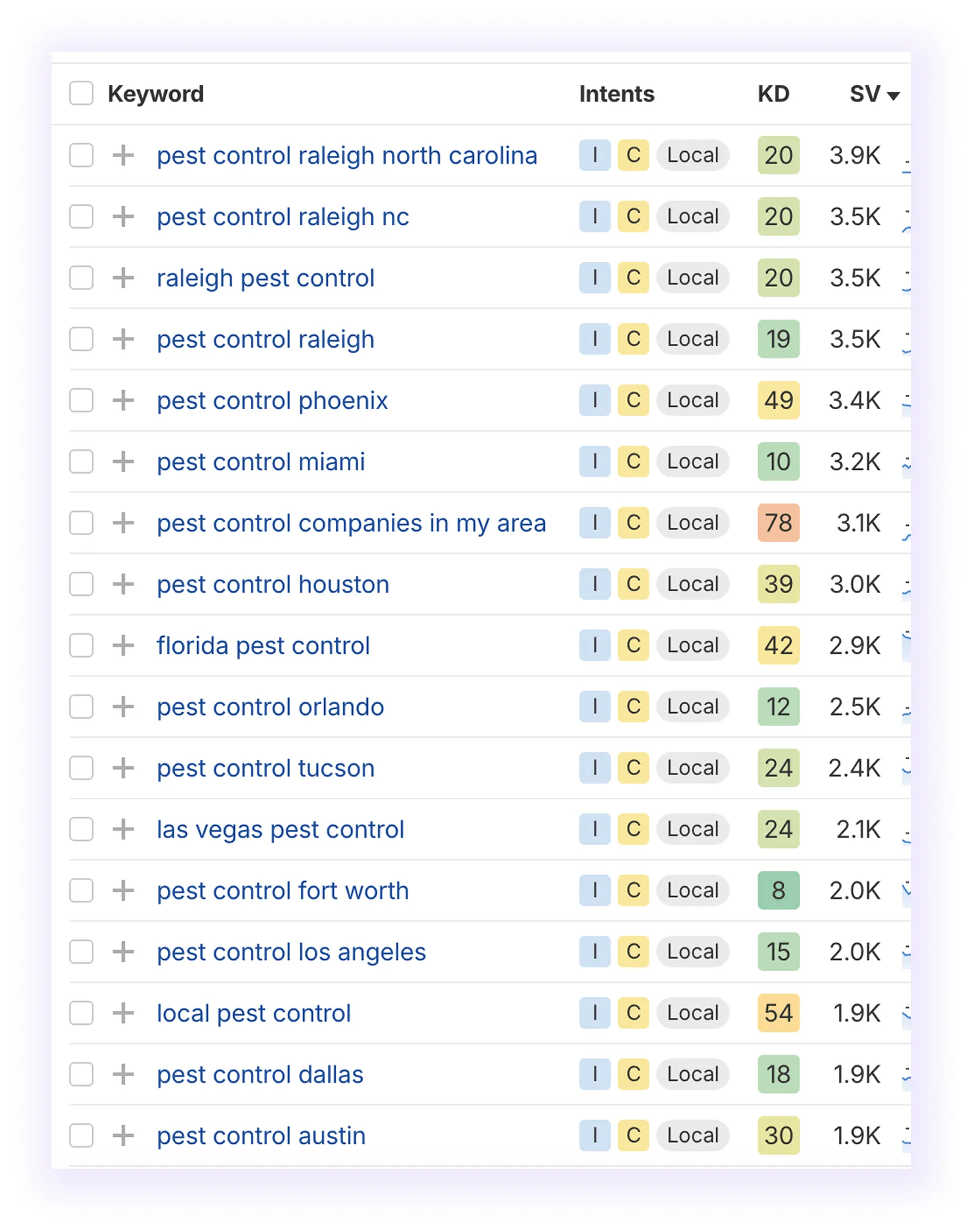
The following keywords are examples of those related to “rod control,” a standard service offered by pest control companies.
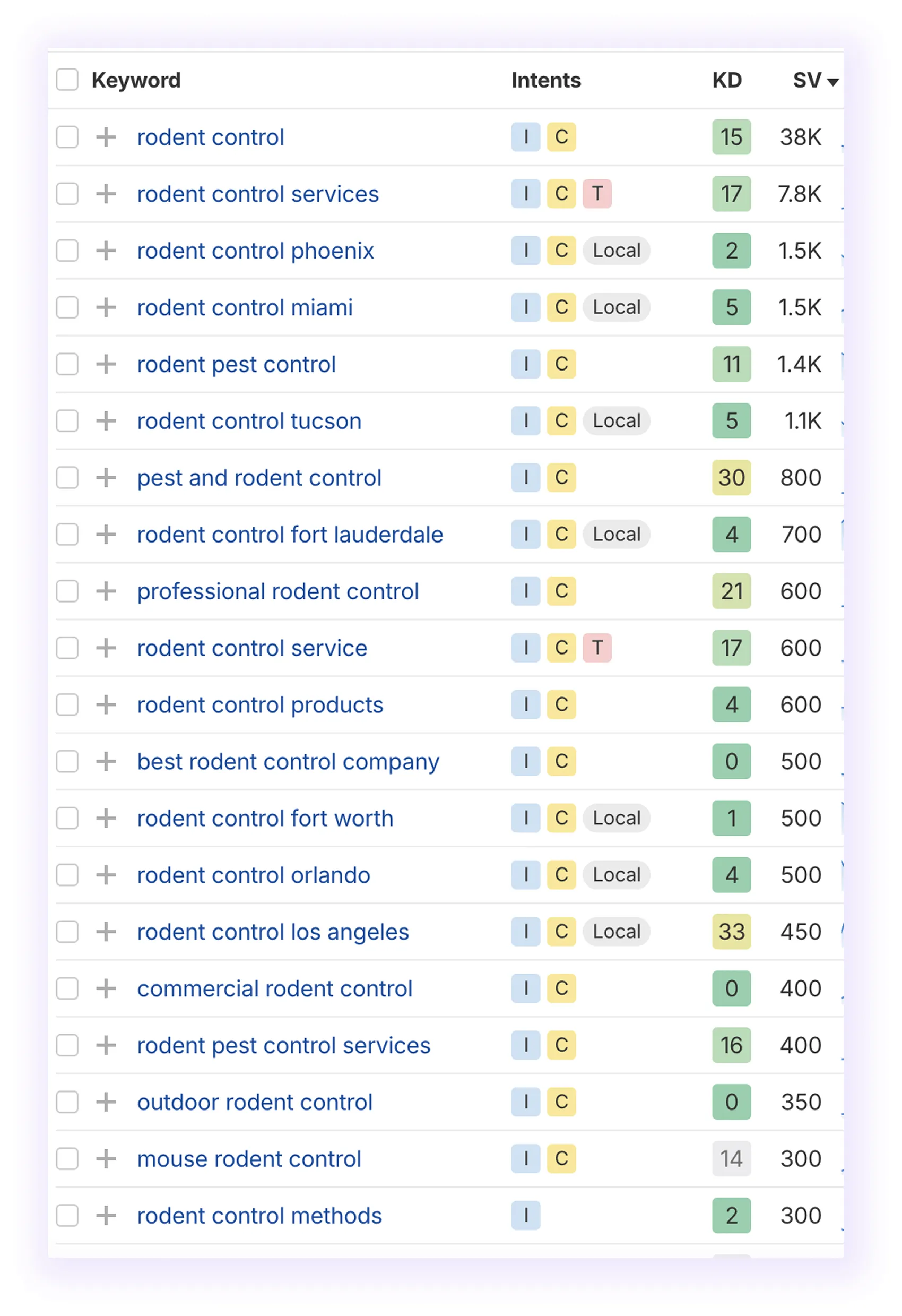
These are just a few keyword examples that you can use for your pest control SEO. But finding the right keywords is only the start. What really matters is turning that research into a strategy that gets your pest control business in front of homeowners the moment they search.
That’s where we come in. We map services to high-intent searches, create pages that rank locally, and position your business ahead of competitors. The best part? Unlike ads, the results keep working long after the campaign is set up.
Think of this step like giving search engines a roadmap: clear structure tells them which pages matter most and helps match you with the right searches. Every pest control website should have:
Your navigation bar should make these pages (plus key services) easy to find from anywhere on the site. See an example below.
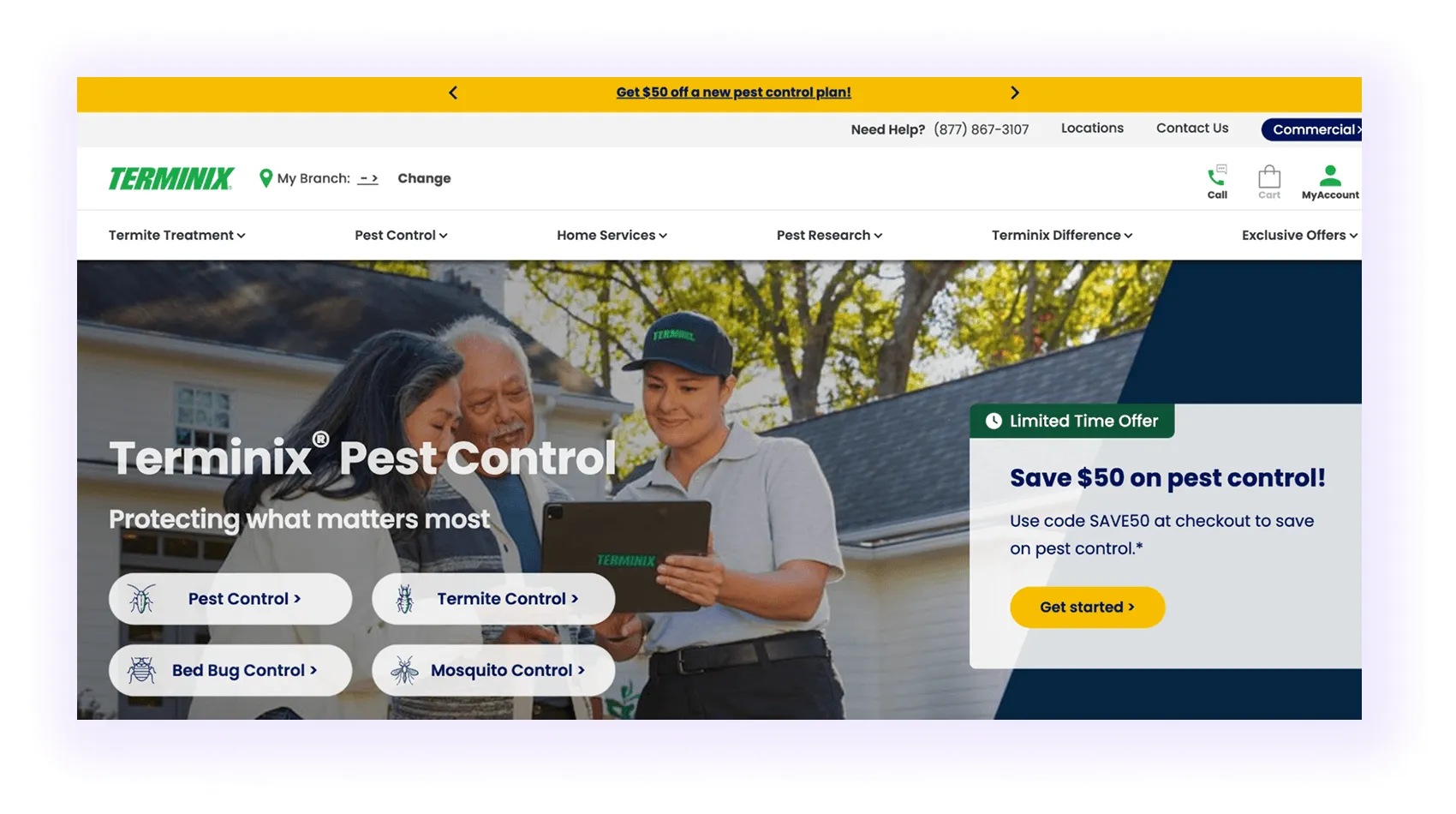
When homeowners search for you online, they’re usually dealing with a specific infestation. To capture these high-intent searches, you need a separate page for each service you provide, with one particular main keyword. Examples include:
These pages do three things: they help you rank for the right keywords, make it easier for customers to find what they need, and show Google the full scope of your expertise.
Add all service pages to your site’s navigation bar, like in the example below.
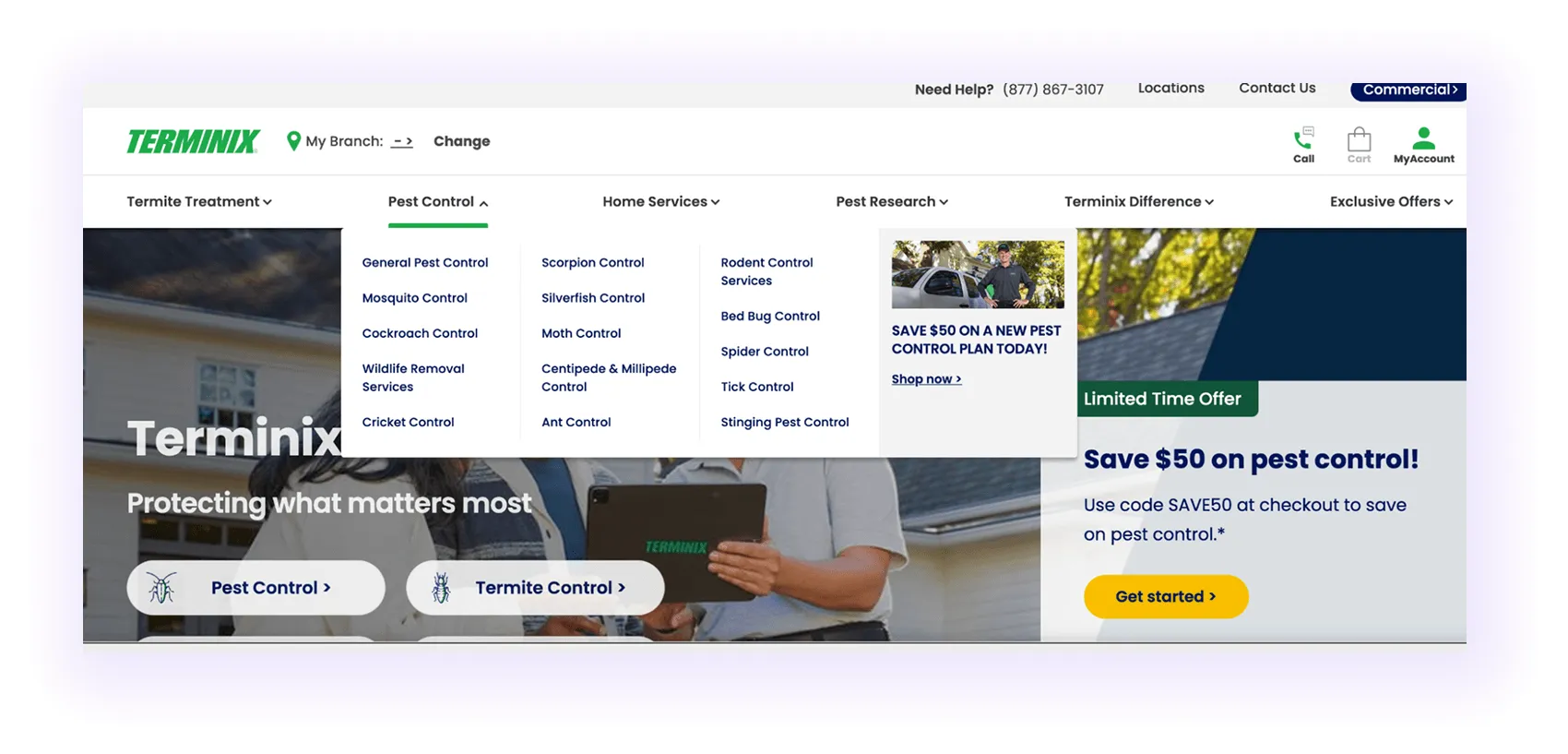
Create separate pages for both residential and commercial pest control. This structure helps Google categorize your services while giving you more chances to rank for specific searches.
It also improves the customer experience. Homeowners seeking “bed bug removal” and business owners requiring “rodent control” can immediately find what applies to them.
From there, add subcategories under each section, like “apartment pest control” or “restaurant pest control,” to target even more precise searches.
Including these pages in your navigation bar makes it simple for visitors to explore both residential and commercial options at a glance.

Targeting location-based keywords is one of the most effective pest control SEO tactics. Phrases like “near me” or “pest control in [city]” show high intent and strong local buying signals.
To capture this traffic, create location-specific service pages for every area you serve. “Rodent control,” “bed bug removal,” or “cockroach extermination” - these pages connect your business directly with customers in that city, boosting visibility and conversions.
Examples of 3-word location-based keywords:
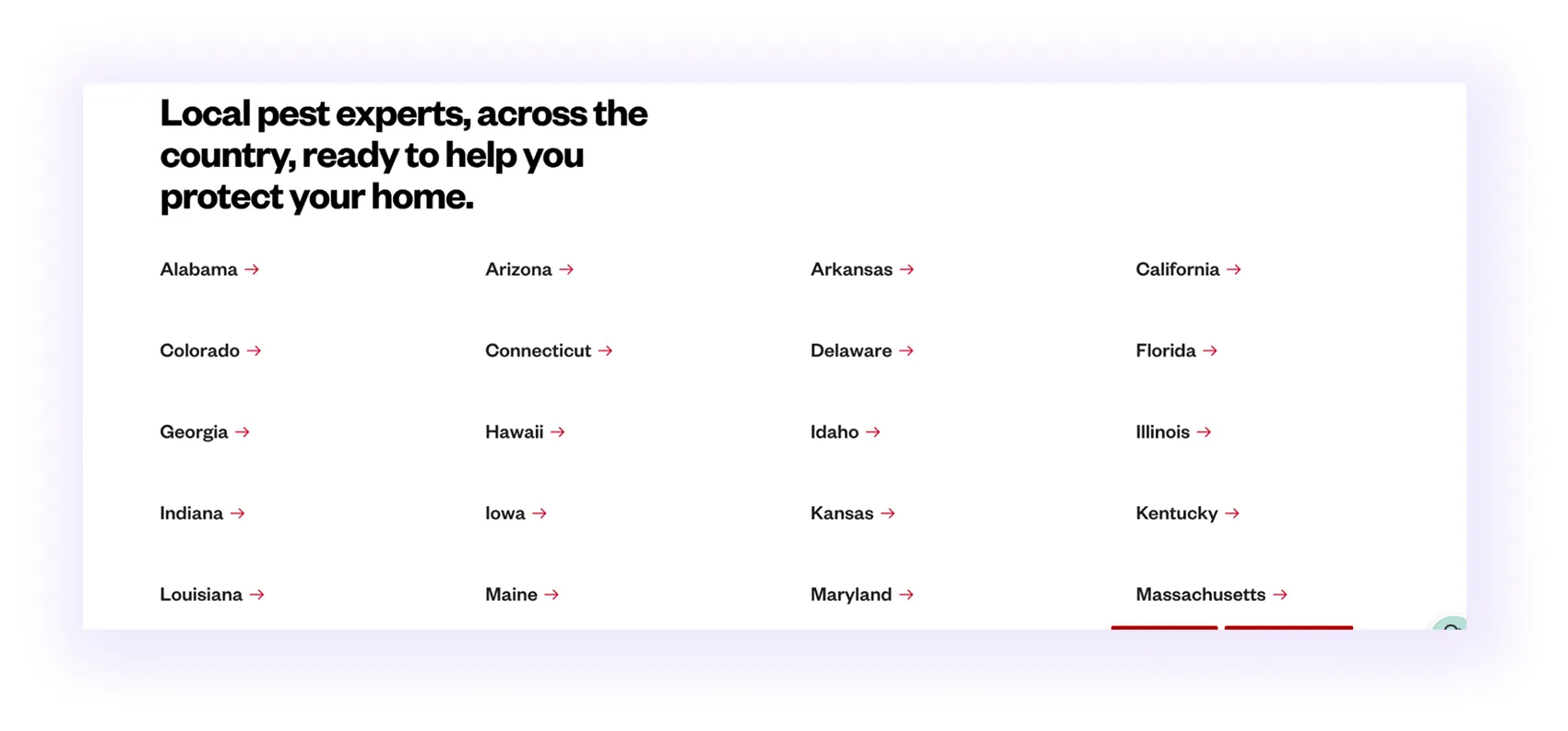
When homeowners face pest problems, they often start with Google searches like:
These questions are perfect blog opportunities. By addressing them, you attract people who may decide they need professional help.
Your blog content should always connect back to a service you provide. This is done through topical clustering; we’ll break it down in more detail later.
Stop Guessing Your Pest Control Website Structure—We Will Show You Exactly What Pages You Need
After analyzing what works (and what doesn’t), we’ve built a proven layout that gets pest control companies found online. Apply it to your site and see the difference.
If you serve a single area, focus on ranking for location-based searches, such as “pest control Los Angeles” or “termite exterminator Florida.” If you cover multiple cities, states, or even nationwide, your strategy should expand with dedicated pages for each service area. Seems simple.
Now we’ll break down exactly how to approach both single-location and multi-location SEO so you can apply what fits your business.
Let’s look at an example. Say your company operates only in Florida. Your homepage should make this evident to both Google and customers by targeting phrases like “pest control company in florida” or “florida termite control.”
That way, search engines know to rank you for Florida searches, and homeowners immediately understand you’re local.
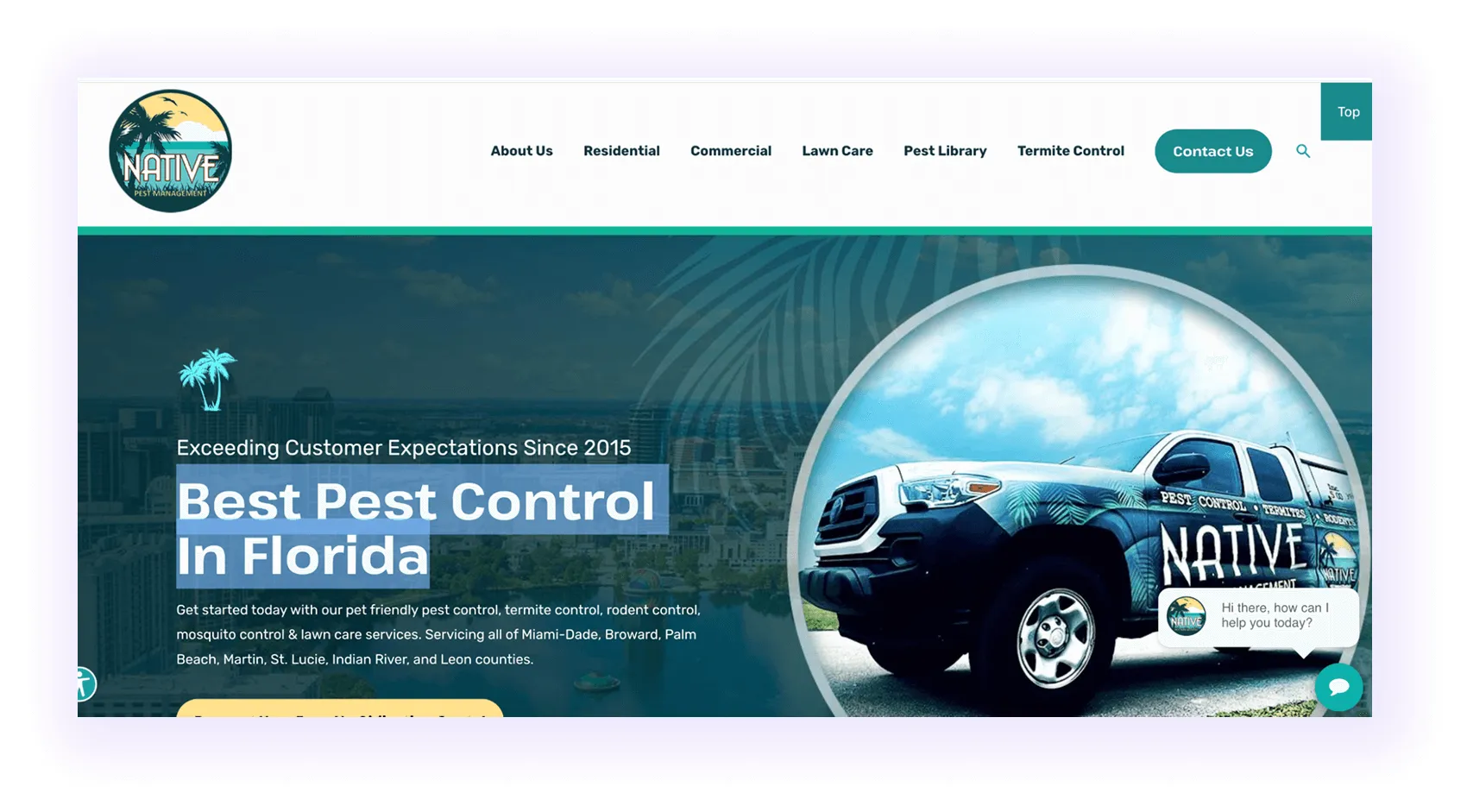
Now imagine your company works in both Florida and Texas. Instead of just one homepage, you’ll need dedicated location pages for each area, so Google knows you serve both states and customers can quickly find the service they need.
Examples of location keywords:
Each page should include the service + location keyword in headings, meta titles, and descriptions, with unique content for that area.
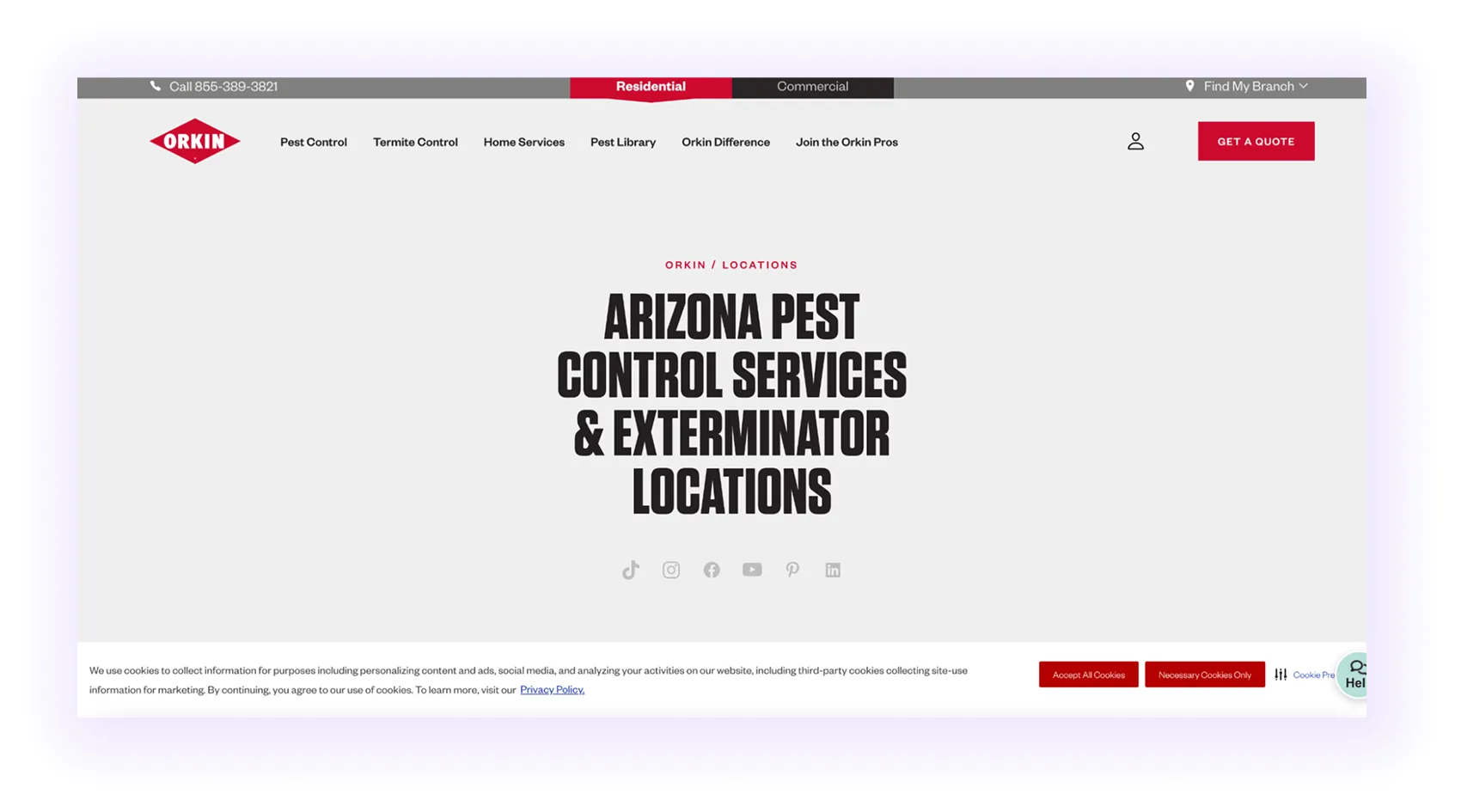
A pro tip: Create a location hub page that links to all the cities or states you serve. This makes navigation easier for homeowners and gives Google a clear structure to follow.
See the example below for a pest control service website that has a specific category for their service locations.
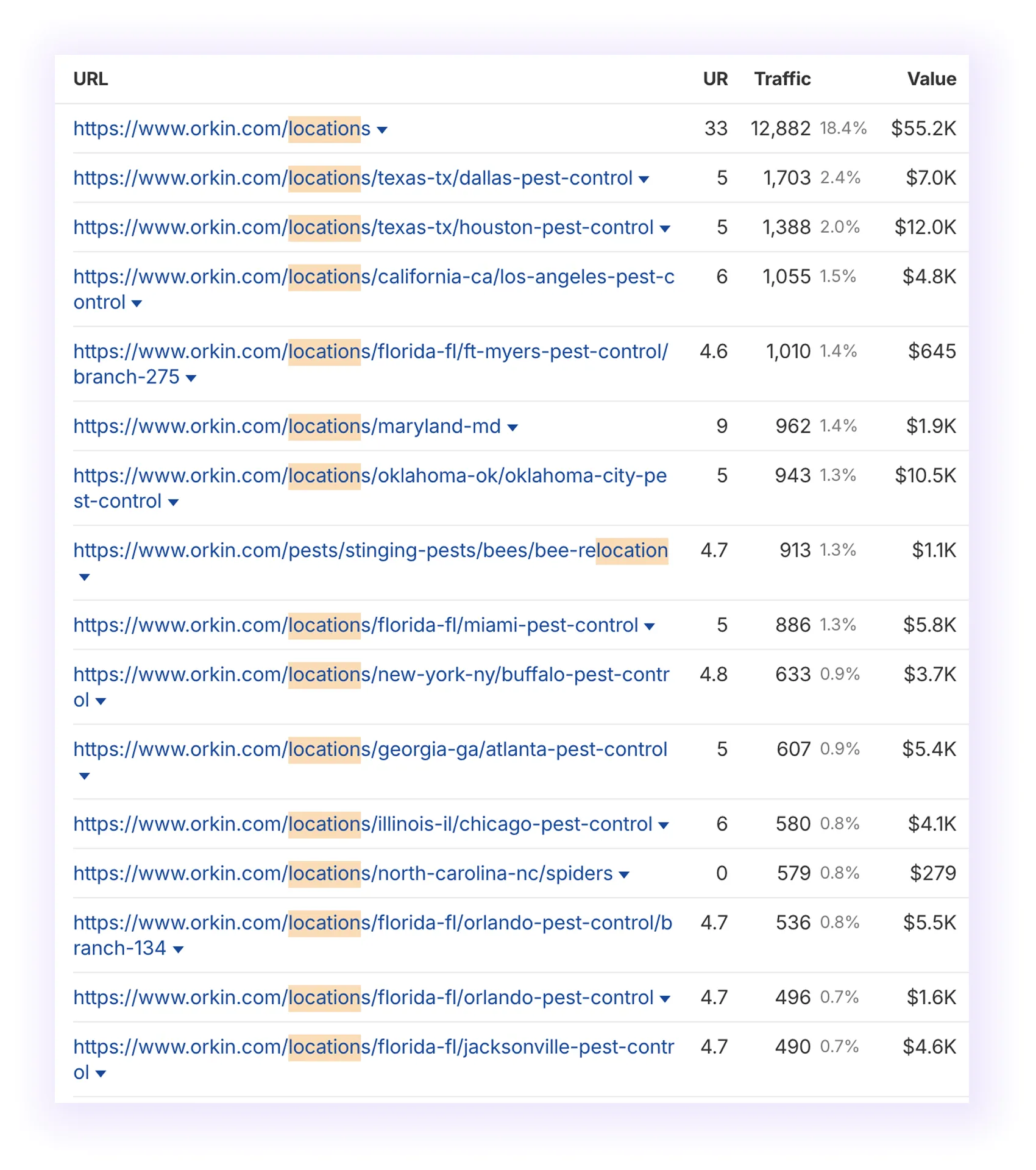
When you search for pest control near you, the first thing you usually see isn’t a website; it’s Google Maps and Google Business Profiles (GBP). For pest control companies, this is prime real estate. If your GBP is optimized, you’ve got a strong chance of showing up here, and that means more calls and more leads.
Here’s how to set it up right:
The screenshots below show a well-optimized pest control GBP with strong reviews, quality images, complete NAP details, social links, and even popular times.
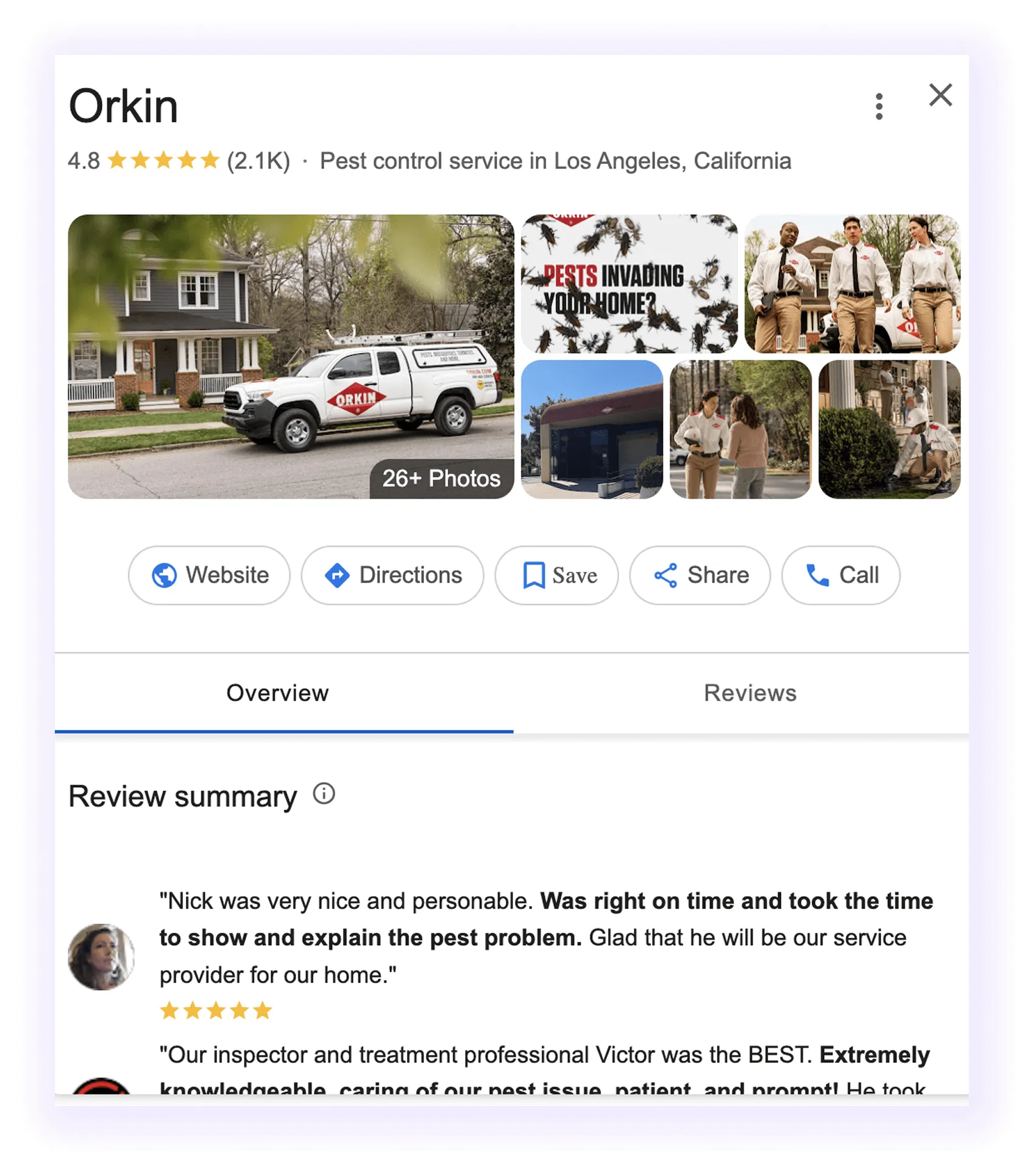
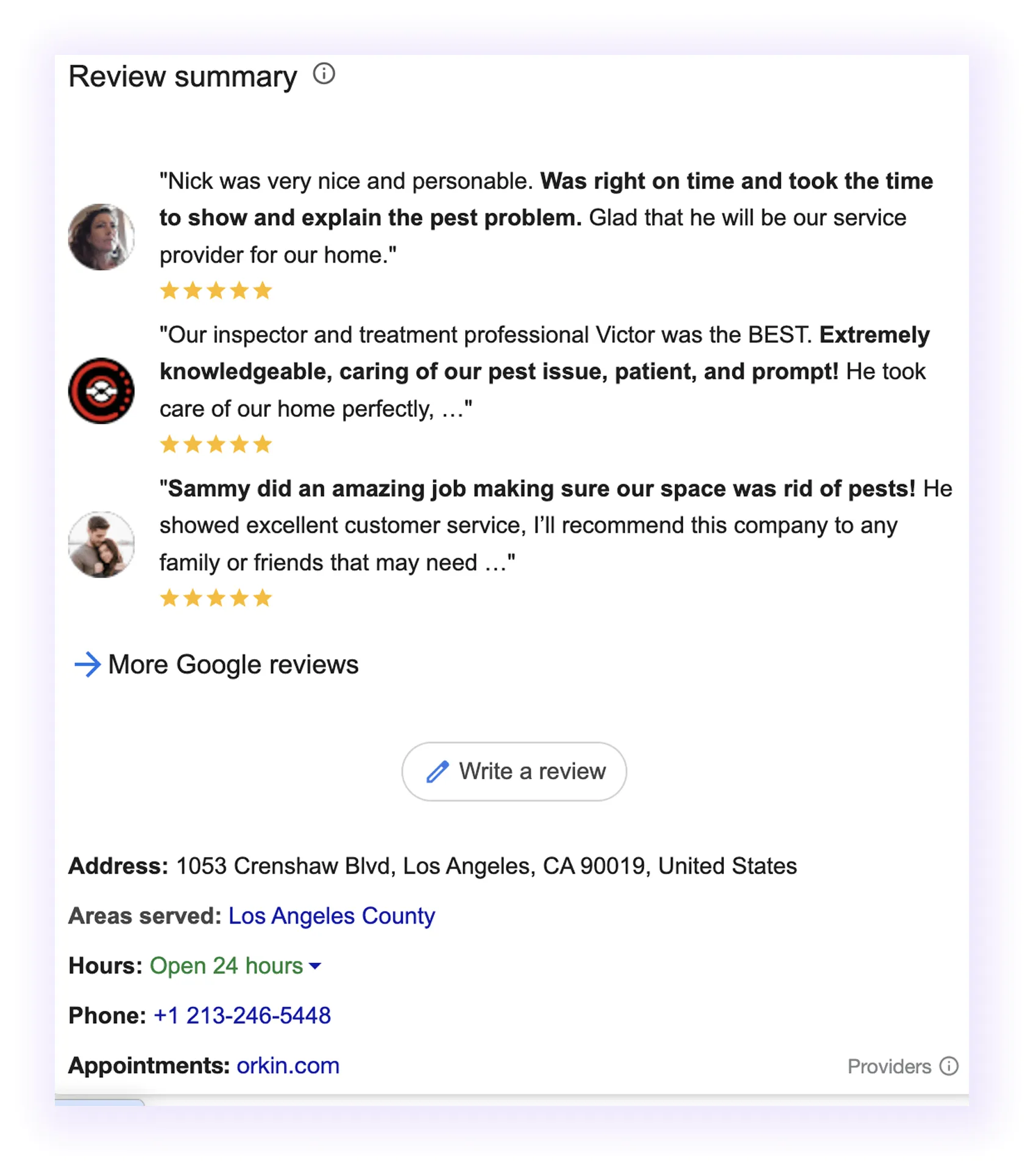

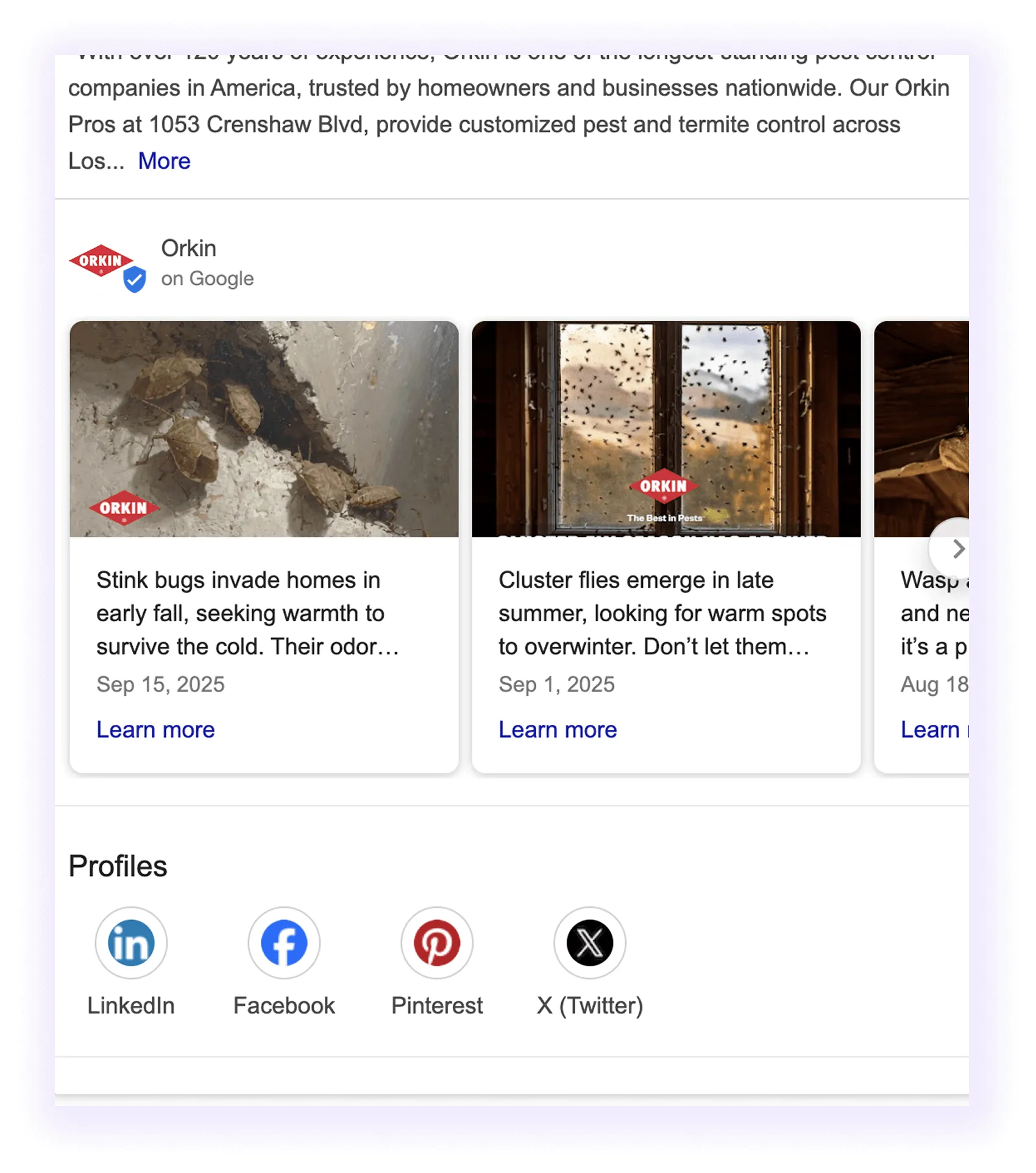
This is what you’ll see on Google Maps:
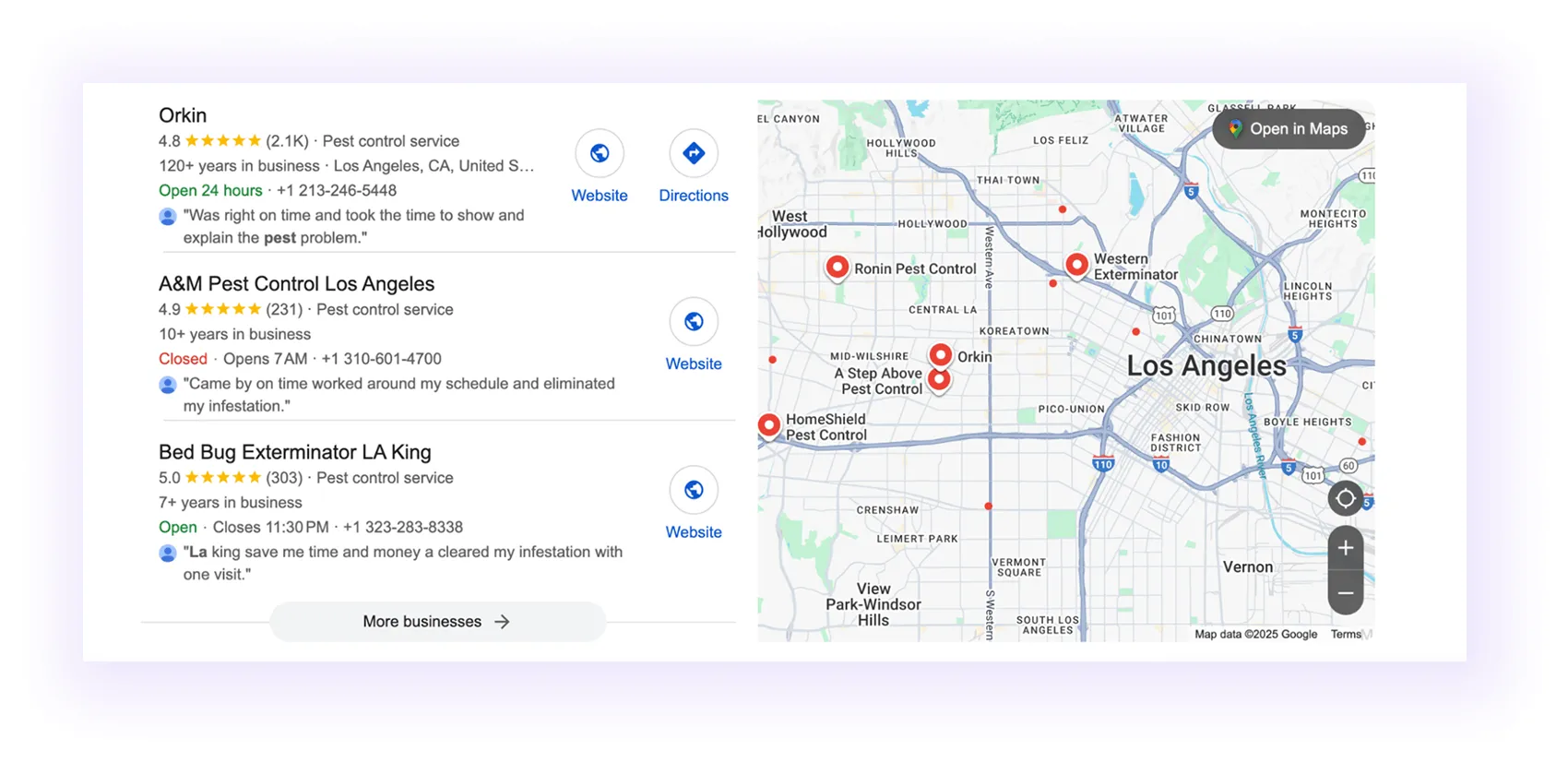
Getting visitors to your site is only step one. Now you need to show them they can trust you to solve their pest problems. The best way to do that? High-quality content that highlights your expertise and makes homeowners feel confident about calling you.
Here’s how you can approach it:
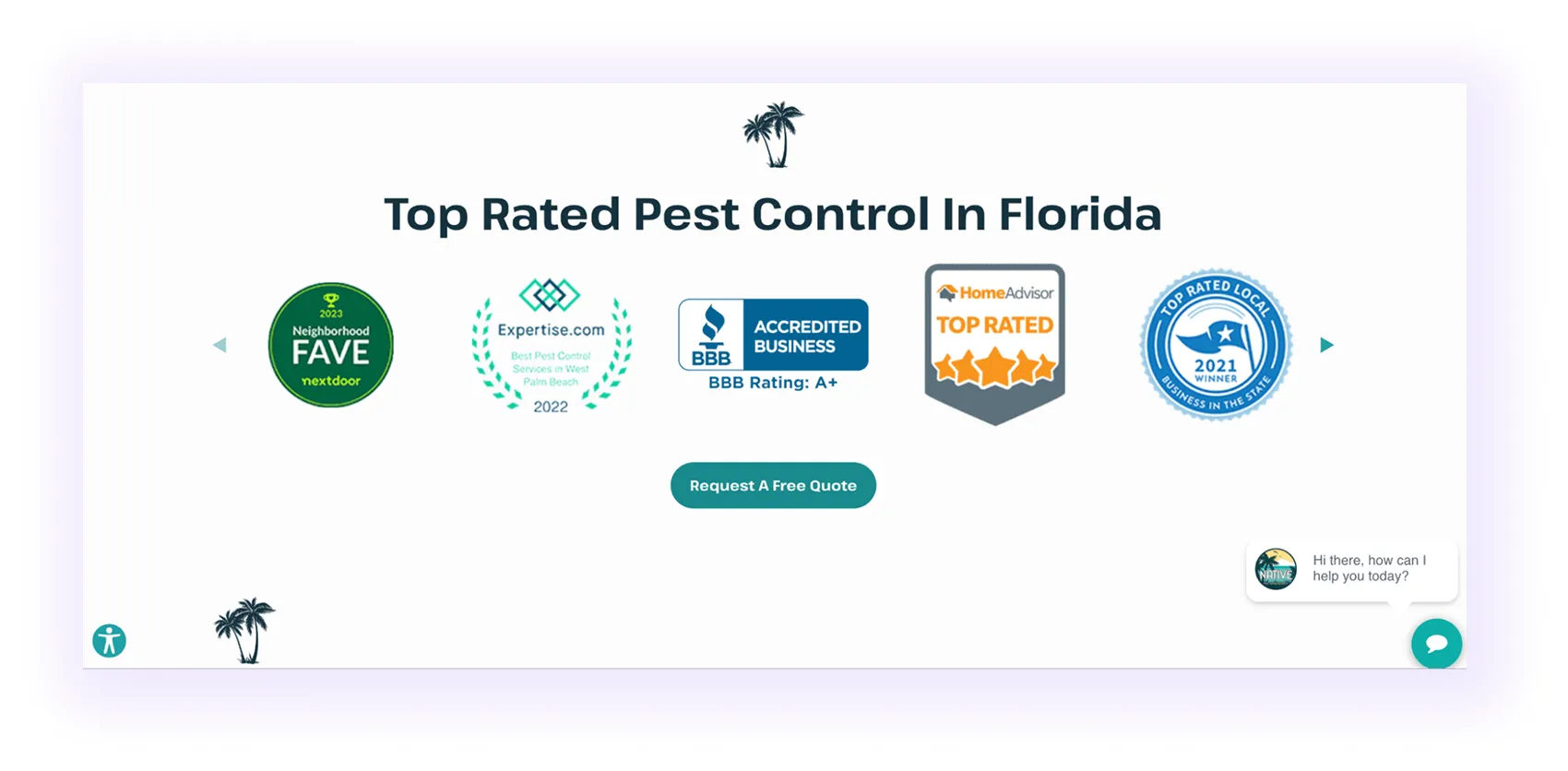
Example:

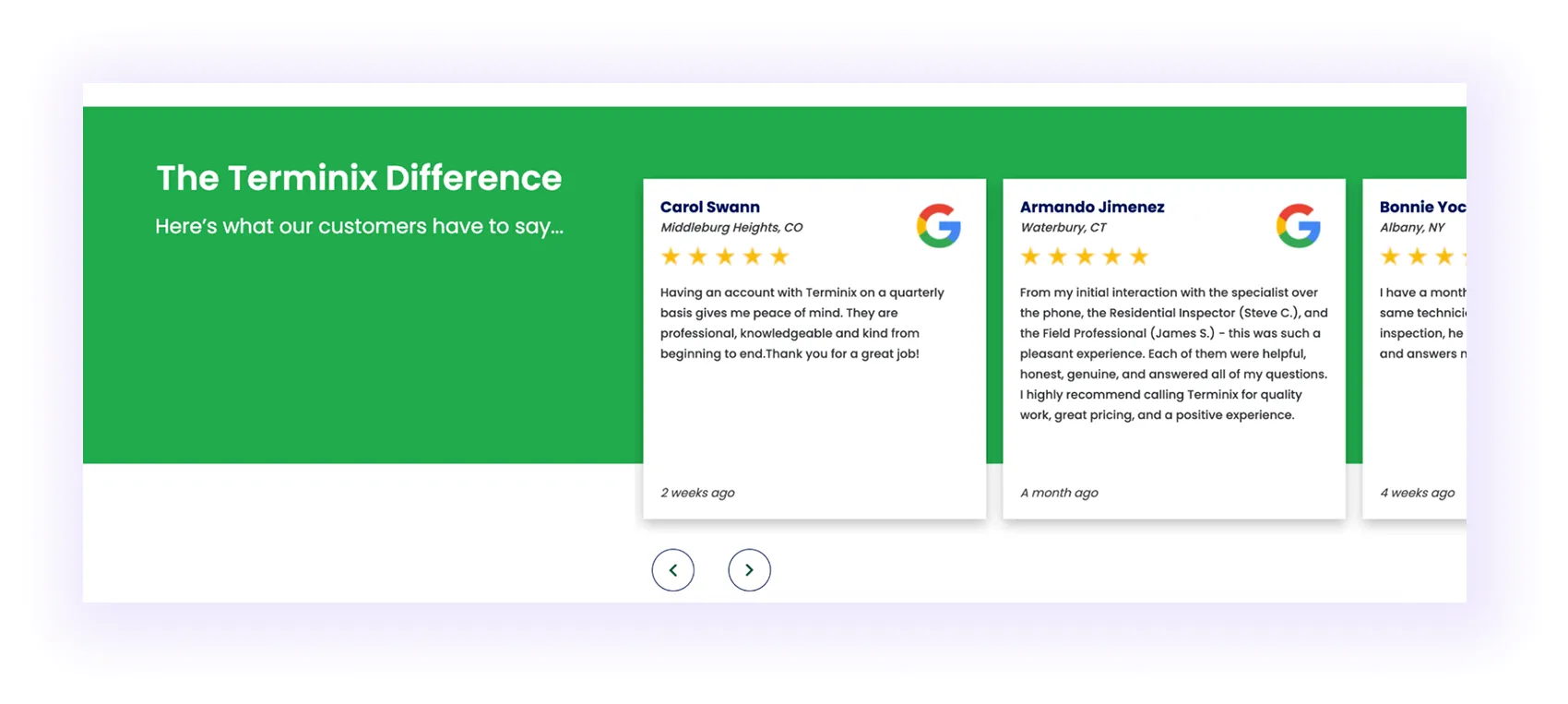
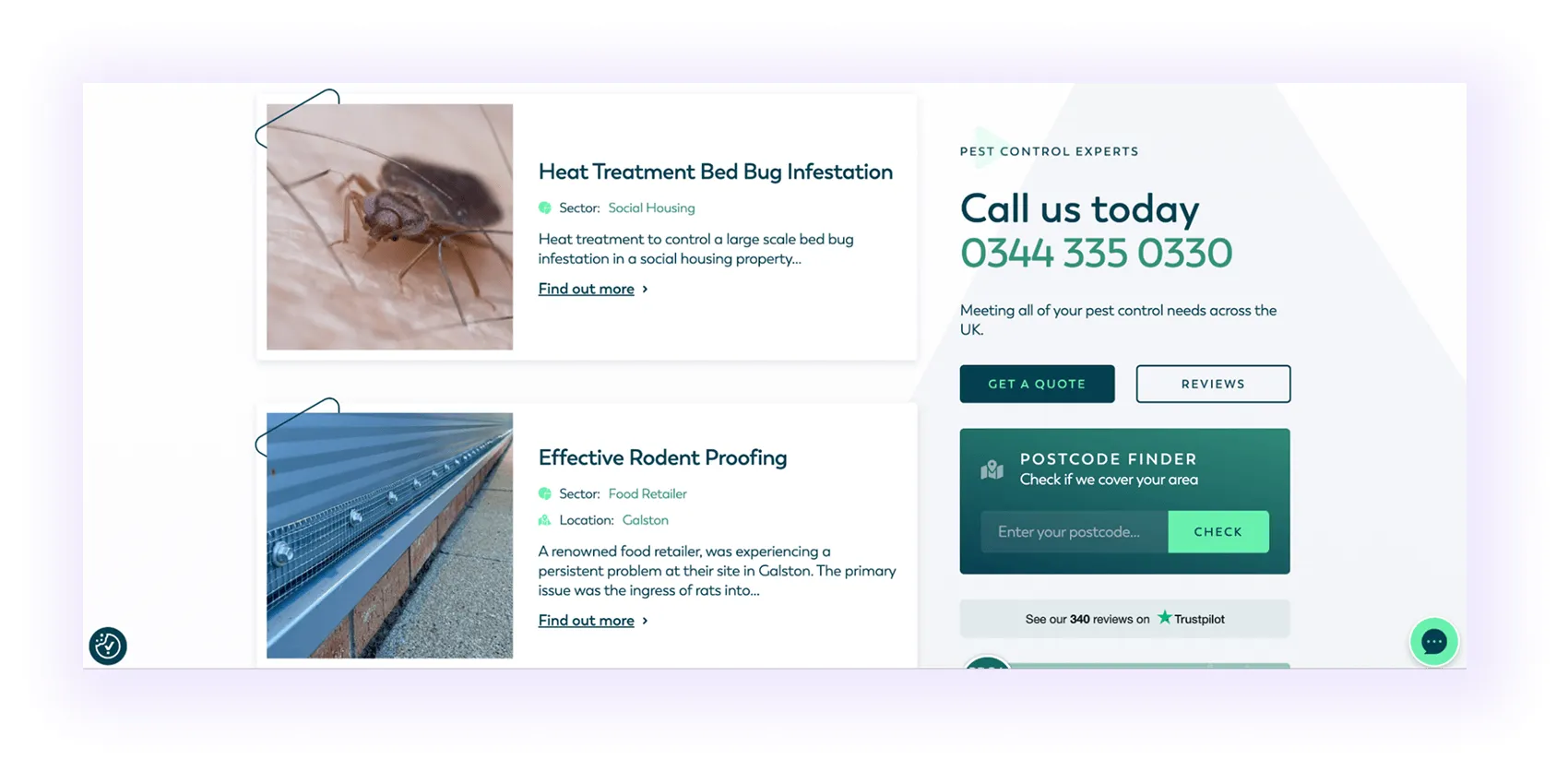
Remember when we mentioned topical clustering earlier? Here’s where it really comes into play.
Homeowners don’t just search for “pest control near me,” they also look up helpful information first. If your site provides answers, you build trust, authority, and visibility in Google’s eyes. And when those homeowners decide they need professional help, you’re the obvious choice.
This is where topic clustering works best. You create a main service page, say “centipede pest control,” and then publish supporting blog posts around it. Each blog links back to the service page, showing Google that your site covers the topic in depth.
Example cluster:
To uncover more blog ideas, check Google’s People Also Ask and Related Searches; they reveal exactly what homeowners want to know.
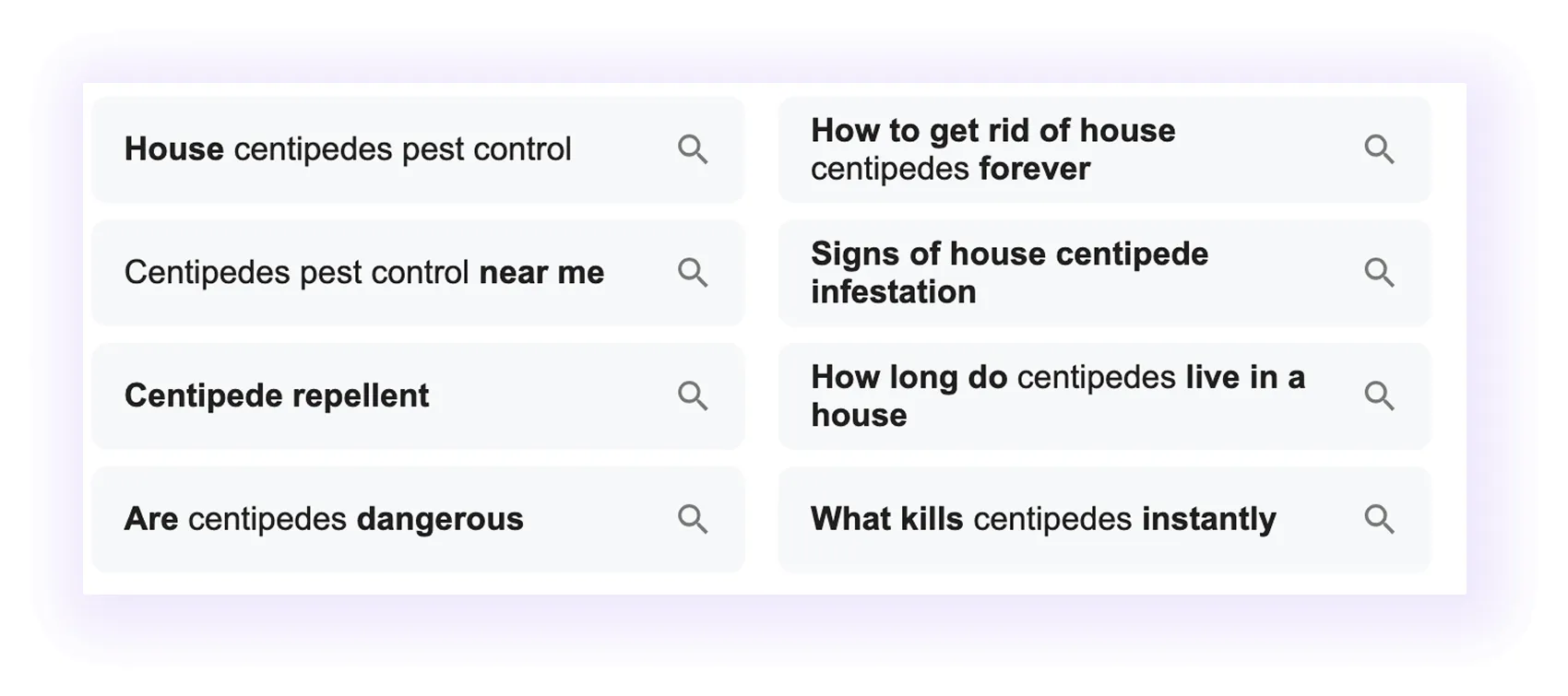
When writing informational blogs for your pest control company, your primary goal is to help visitors solve their problems step-by-step. Here’s how to do it effectively:
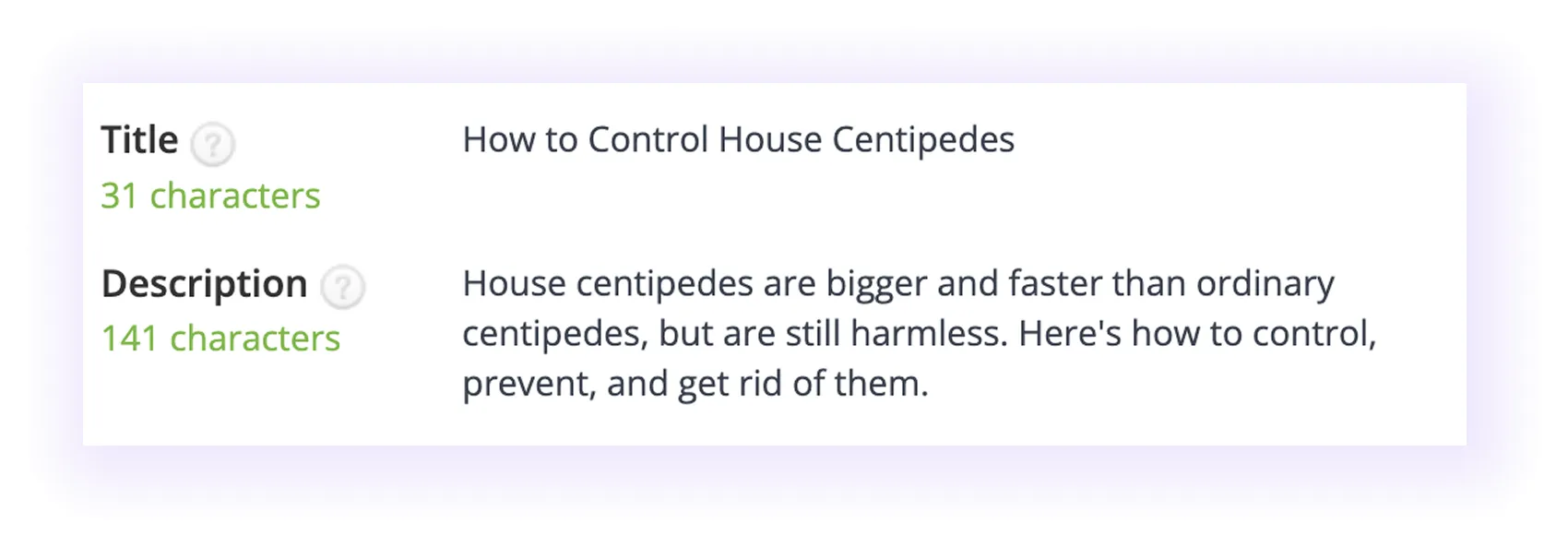
Content may bring visitors in, but think about it: when someone’s dealing with termites or a rodent problem, they’re not waiting for a sluggish site to load. Your pages need to be fast, clear, and easy for Google to crawl, and it’s done with proper technical SEO for pest control companies.
Key elements to get right:

Think of schema markup as a way to introduce your pest control company directly to Google. Instead of just crawling your pages, Google gets a clear explanation of what you do: termite control, rodent removal, or bed bug treatments.
With the correct structured data in place, you can highlight:
This extra layer of information helps your site appear in rich results, like star ratings under your listing or FAQ dropdowns, making your business stand out in search.
Here’s an example of how schema looks when applied to a pest control website:
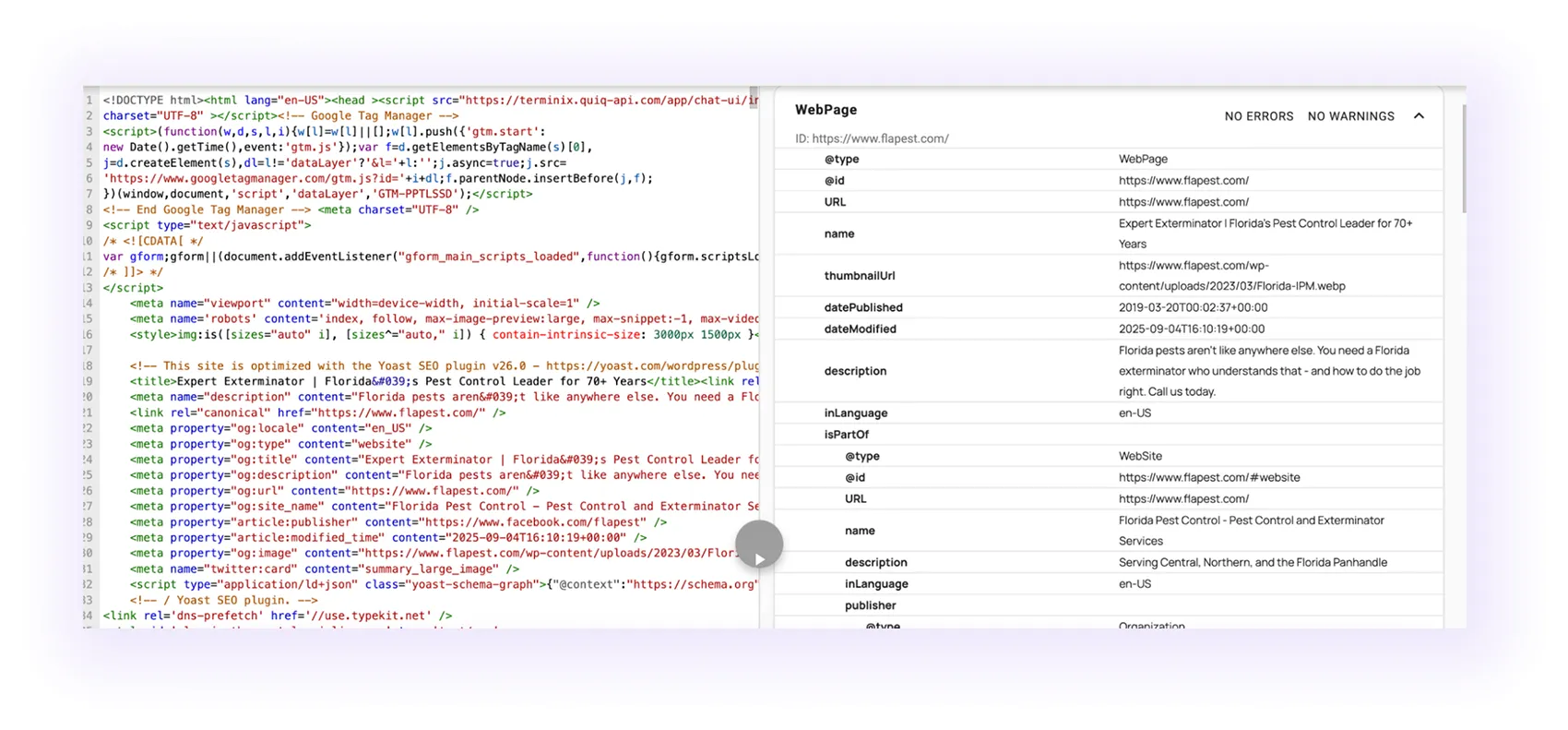
WebPage schema is a start, but pest control companies see the biggest impact by adding multiple schema types. The right mix helps Google display richer results and makes your business stand out in search:
Using this mix tells Google exactly who you are and what you offer, while also making your search listings more clickable and trustworthy.
For better pest control SEO, keep your service page URLs short, clear, and easy to read. Skip numbers, symbols, or codes.
Example of an SEO-friendly URL:
www.yourpestcontrolcompany.com/bed-bug-pest-control-florida
Example of a non-SEO-friendly URL:
www.yourpestcontrolcompany.com/page?id=12345
Next up: internal links. They help Google understand your site and guide homeowners to the right services. Done right, they improve rankings and make your site easier to navigate.
Smart ways to use them:
Some pest control websites even link from service hub pages with pest images as clickable paths, making navigation faster and more engaging. See the example below:
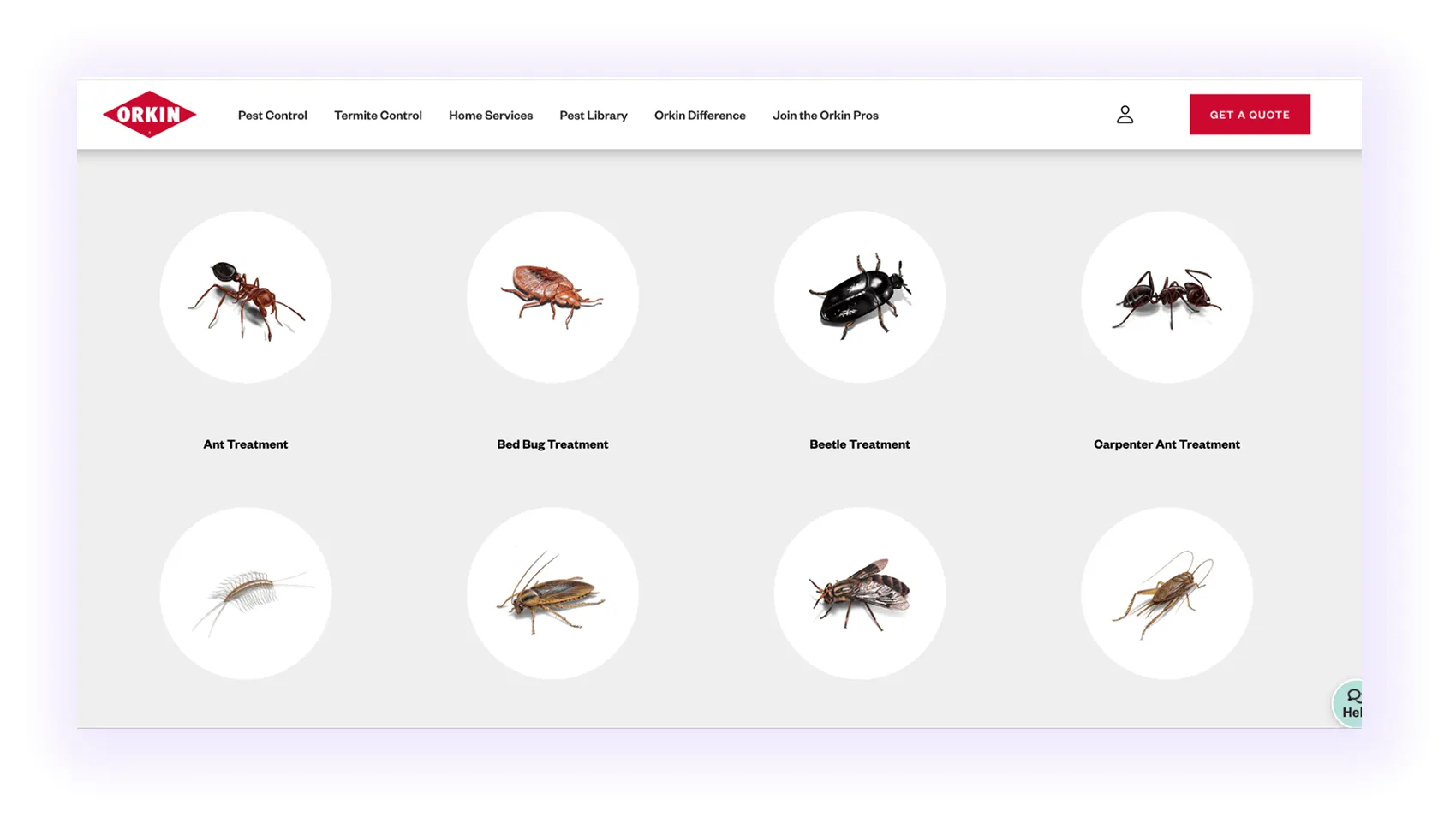
Most pest control searches start on a phone, so if you want business calls to happen, your site should be mobile-friendly. A mobile-optimized pest control site should have:
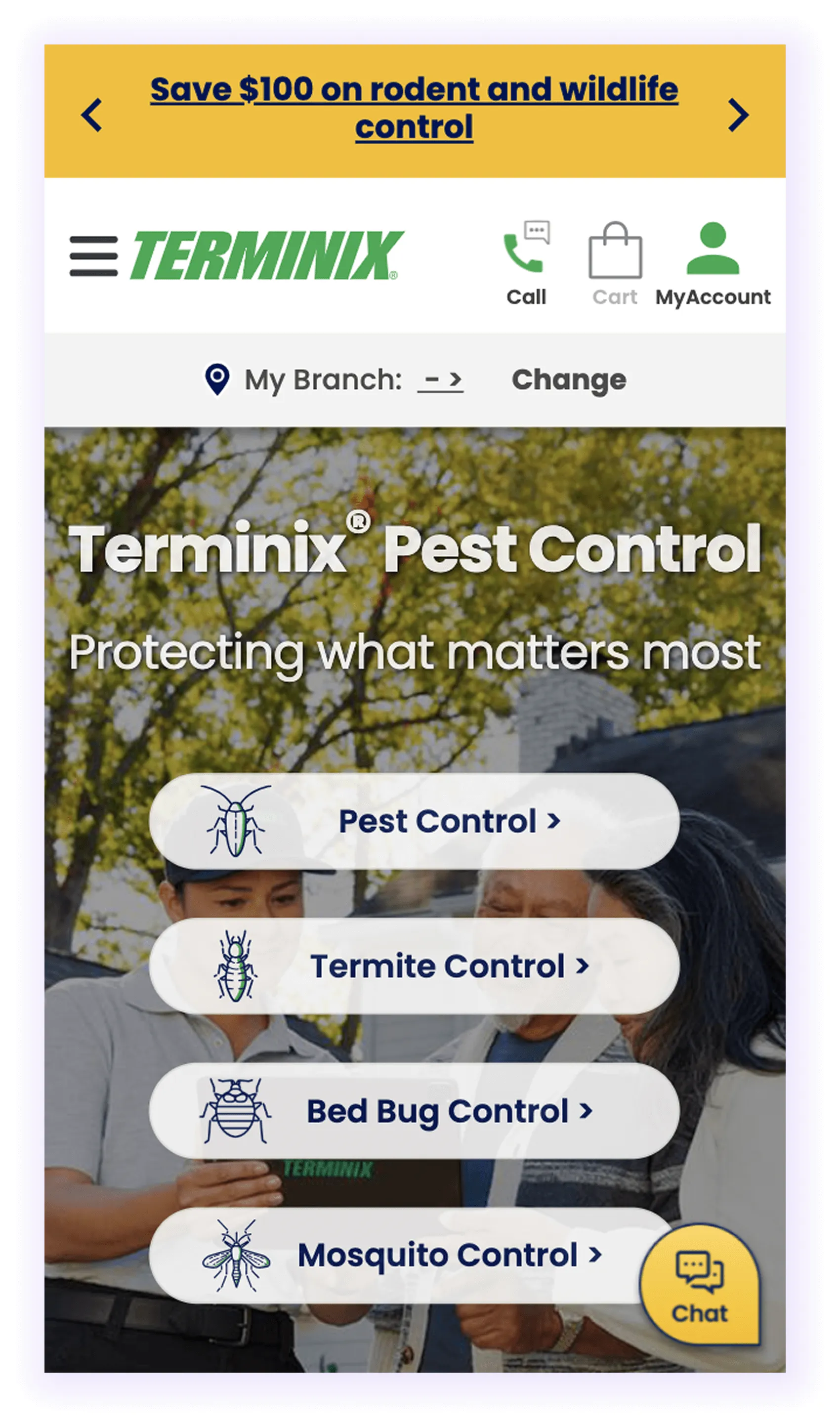
Slow load times and layout shifts hurt rankings; so, tune performance to hit Google’s Core Web Vitals:
Use Google PageSpeed Insights or GTmetrix to check performance. For pest control websites, aim for a score above 85 and hit these benchmarks.
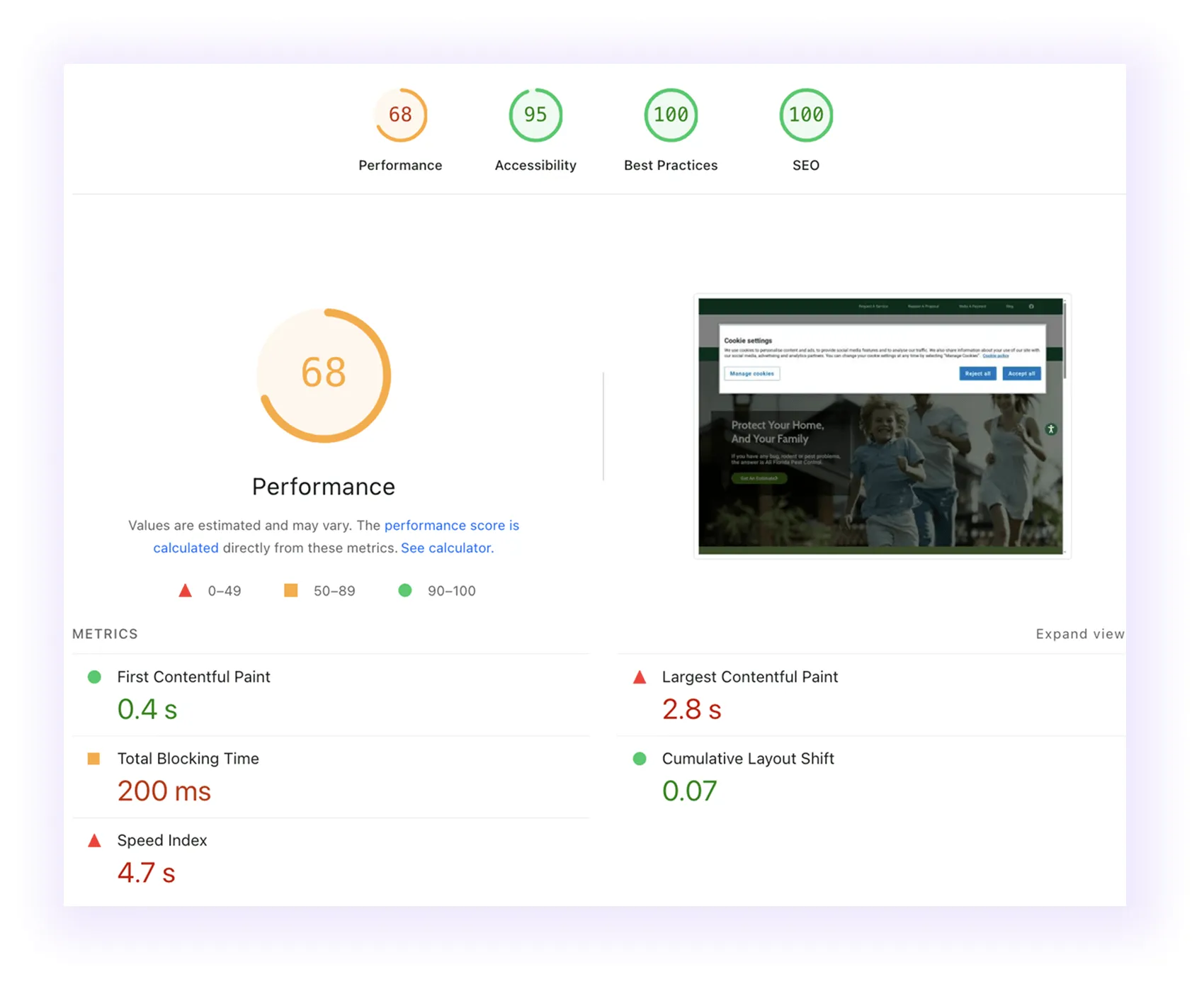
Also, pay attention to the Core Web Vitals for your pest control site:
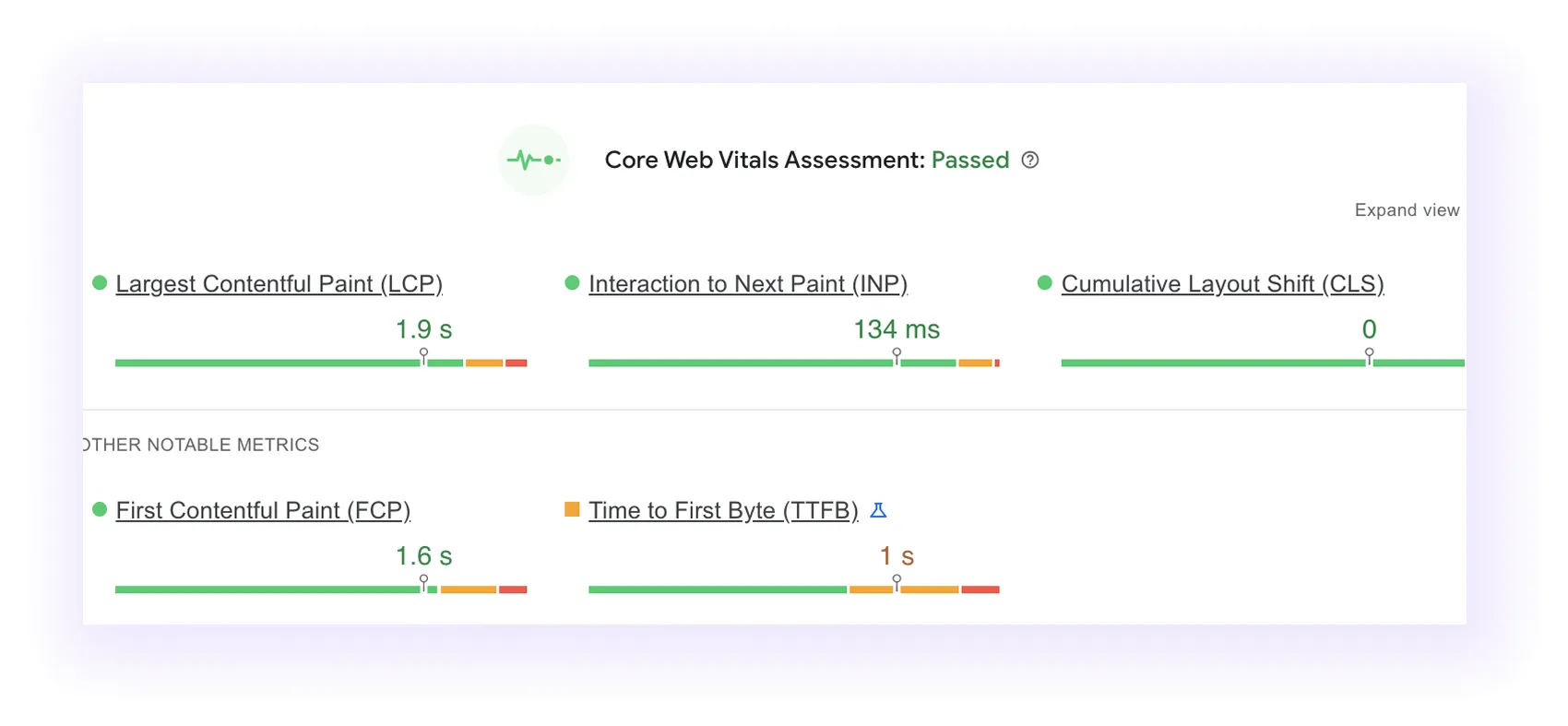
Lastly, constant technical audits on your pest control site are a must for SEO for pest control companies. Even small updates, like adding a new service page or swapping images, can cause issues without you noticing. When you know where the problem is, you can fix it quickly.
In your audits, review everything we’ve covered in this section and don’t overlook broken links or 404 errors, which waste traffic and frustrate visitors.
Tools like Google Search Console or Screaming Frog help you catch most of these issues.
Still, if you want a deeper analysis, pest control SEO experts can run a full 150-point technical checklist to uncover everything that needs improvement.
You’ve optimized your site, but to get the full benefits of pest control SEO, Google also needs to see that others trust you. That trust comes from being mentioned on high-quality, relevant websites.
For pest control companies, the best mentions often come from industry publications, local directories, home maintenance blogs, or even eco-friendly and property management sites. Next, we’ll break down how to build these links the right way.
First, you can and should write useful pest control content for well-known sites; this is guest posting. The goal is to provide real value, not just a link. Good topics include seasonal pest prevention tips, eco-friendly treatments, or signs of common infestations.
Next is link insertion. Instead of writing a new article, you add your expertise to existing content, often by contributing a fresh angle or insight. This lets you earn backlinks directly from high-authority posts already ranking.
Both strategies work well with sites like:
Listing your pest control business in trusted directories builds authority and helps customers find you. Focus on both general business directories and pest control-specific ones.
When setting up profiles, ensure consistency in details, including business name, address, phone number, and website (NAP). Add a short description of your services, upload quality photos, and update listings with seasonal offers or new services. Reviews matter too, so respond actively to build trust.
Good directories to target for pest control companies include:
This is how your profile should show up in these directories:
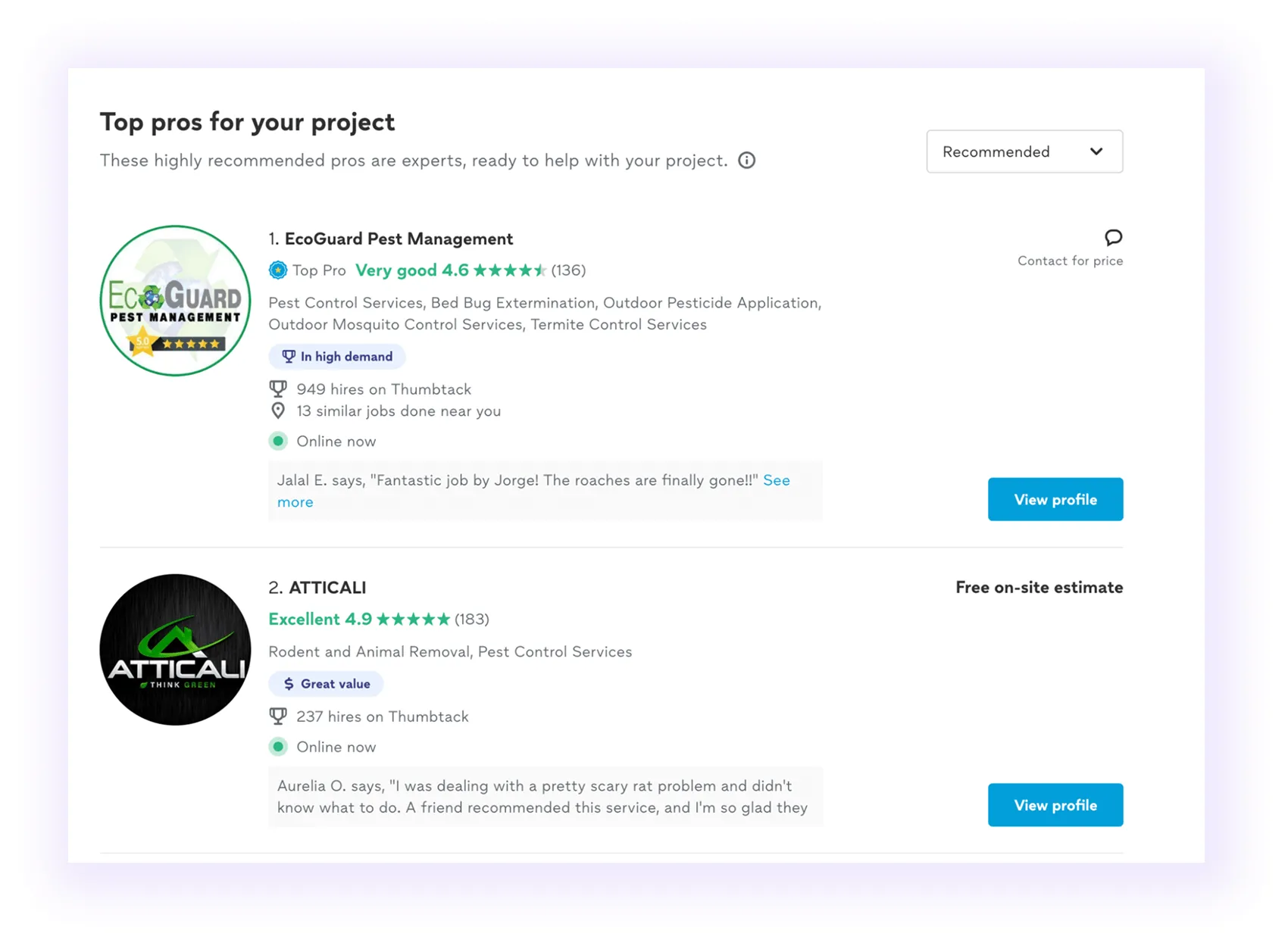
Last but not least: digital PR. It’s when you create great stories, insights, or news related to pest control with a goal to drive journalists’ and industry sites’ interest. They will take those stories and spread them, while giving you high-quality backlinks, literally growing your authority organically, without payment.
Example of a website:
Topic Example:
Top 10 Unexpected Pests Found in Luxury Homes and How They Get There
Let’s look at it through real scenarios you might see when running your business:
By watching these metrics with the right tools, you’ll know if your pest control SEO is driving real results: stronger visibility, steady calls, and more booked jobs.
You’ve seen how much goes into pest control SEO: keyword research, technical audits, content, backlinks, and more. Managing it all on your own means juggling multiple tools and still risking gaps.
As one of the best pest control SEO agencies, we’ve worked with over 100 pest control companies, so we know precisely what drives calls and steady growth. Instead of piecing it together yourself, partner with a team that already understands your industry inside and out, and let us help you win more customers, faster.
Submit the form - Get Free Proposal
%202.png)
24 hours